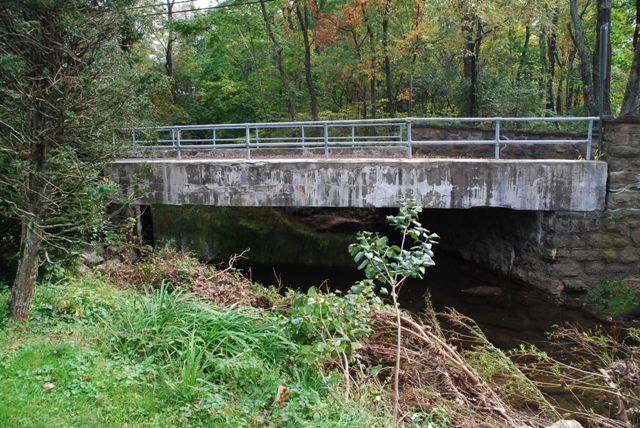We Recommend:
Bach Steel - Experts at historic truss bridge restoration.
BridgeHunter.com Phase 1 is released to the public! - Visit Now
Pikeland Avenue Bridge

Primary Photographer(s): Elaine Deutsch
Bridge Documented: October 10, 2011
Rural: Chester County, Pennsylvania: United States
1916 By Builder/Contractor: John Parker Corcoran Construction Company of West Chester, Pennsylvania and Engineer/Design: Nathan R. Rambo
Not Available or Not Applicable
28.0 Feet (8.5 Meters)
33.0 Feet (10.1 Meters)
19.7 Feet (6 Meters)
1 Main Span(s)
15701504670272

View Information About HSR Ratings
Bridge Documentation
View Archived National Bridge Inventory Report - Has Additional Details and Evaluation
This bridge is one of a fair number of similar bridges in Chester County that are of unusual design. While not highly significant in terms of beauty or heritage value, they are unusual because they combine a traditional stone substructure with a cutting edge (for the period) reinforced concrete and steel superstructure. They appear to be confined to Chester County, having been designed by the county. The superstructure is a steel stringer bridge with a concrete deck. Stringers are encased in concrete using the jack-arch method, which was a method used briefly in the early 20th Century. The outside of the superstructure is also faced in concrete, which extends above the deck to hold the pipe railing system.
Information and Findings From Pennsylvania's Historic Bridge InventoryDiscussion of Bridge The skewed, one-span, 33'-long, steel stringer bridge, built in 1916, has a concrete jack arch deck. It is finished with curb-mounted, two-high rail pipe railings. It is supported on stone abutments. Flared stone wingwalls with parapets enclose the approaches. Over 110 examples of steel stringer with concrete jack arch deck bridges have been identified statewide from 1905 to 1956, with approximately 50 dating to before 1916. They enjoyed a period of popularity during the mid 1910s in Chester County under the direction of County Engineer Nathan R. Rambo, who favored the design because of its simplicity, compactness, and economy. The county has 14 identified examples from 1913 to 1918, more than any other county in the state. Complete, prototypical examples from before 1915 are considered significant in the Chester County context, reflecting the local application of national thinking about bridge technology and design. This 1916 example is not historically or technologically distinguished by its setting or context. Discussion of Surrounding Area The bridge carries a 2 lane road over a stream in a setting with scattered mix of 19th and late-20th-century residences. A ca. 1800 stone residence is located approximately 200' north of the bridge. The other quadrants are wooded. Approximately 300' south on Pikeland Avenue is a late-20th-century residential subdivision. The setting does not have the cohesiveness of a potential historic district. Bridge Considered Historic By Survey: No |
![]()
Photo Galleries and Videos: Pikeland Avenue Bridge
Bridge Photo-Documentation
Original / Full Size PhotosA collection of overview and detail photos. This gallery offers photos in the highest available resolution and file size in a touch-friendly popup viewer.
Alternatively, Browse Without Using Viewer
![]()
Bridge Photo-Documentation
Mobile Optimized PhotosA collection of overview and detail photos. This gallery features data-friendly, fast-loading photos in a touch-friendly popup viewer.
Alternatively, Browse Without Using Viewer
![]()
Maps and Links: Pikeland Avenue Bridge
Coordinates (Latitude, Longitude):
Search For Additional Bridge Listings:
Bridgehunter.com: View listed bridges within 0.5 miles (0.8 kilometers) of this bridge.
Bridgehunter.com: View listed bridges within 10 miles (16 kilometers) of this bridge.
Additional Maps:
Google Streetview (If Available)
GeoHack (Additional Links and Coordinates)
Apple Maps (Via DuckDuckGo Search)
Apple Maps (Apple devices only)
Android: Open Location In Your Map or GPS App
Flickr Gallery (Find Nearby Photos)
Wikimedia Commons (Find Nearby Photos)
Directions Via Sygic For Android
Directions Via Sygic For iOS and Android Dolphin Browser
USGS National Map (United States Only)
Historical USGS Topo Maps (United States Only)
Historic Aerials (United States Only)
CalTopo Maps (United States Only)

